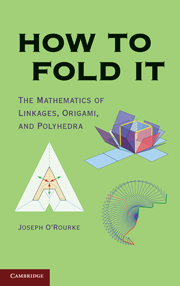5 - Fold and One-Cut
Published online by Cambridge University Press: 05 June 2012
Summary
The most impressive result of mathematical origami discovered to date is so surprising that it has been used as a magic trick by none other than Harry Houdini, the great magician. The result is this. Make any straight-line drawing on a sheet of paper. For example, you might draw a number of shapes: a rectangle, a triangle, a star, some block letters, and so on (but no circles or other curves). See Figure 5.1. Then it is possible to (cleverly!) fold the paper flat so that, with one straight scissors cut completely through the paper, all the shapes you drew are simultaneously cut out, leaving the original paper missing exactly those shapes.
Examples
Square. This is so hard to believe that we'll start with a simple example so that you see that it at least might be possible: a square centered on a square piece of paper; see Figure 5.2. To cut out this shape, we must fold the paper to place the four edges of the square aligned on top of one another. Call the four corners of the square A, B, C, D as in (b) of the figure. Crease the paper with a mountain fold along diagonal AC. This aligns the bottom edge AB with the left edge AD underneath, and similarly aligns the right edge BC with the top edge CD. Now the square boundary has become an L-shape.
- Type
- Chapter
- Information
- How to Fold ItThe Mathematics of Linkages, Origami, and Polyhedra, pp. 72 - 83Publisher: Cambridge University PressPrint publication year: 2011



